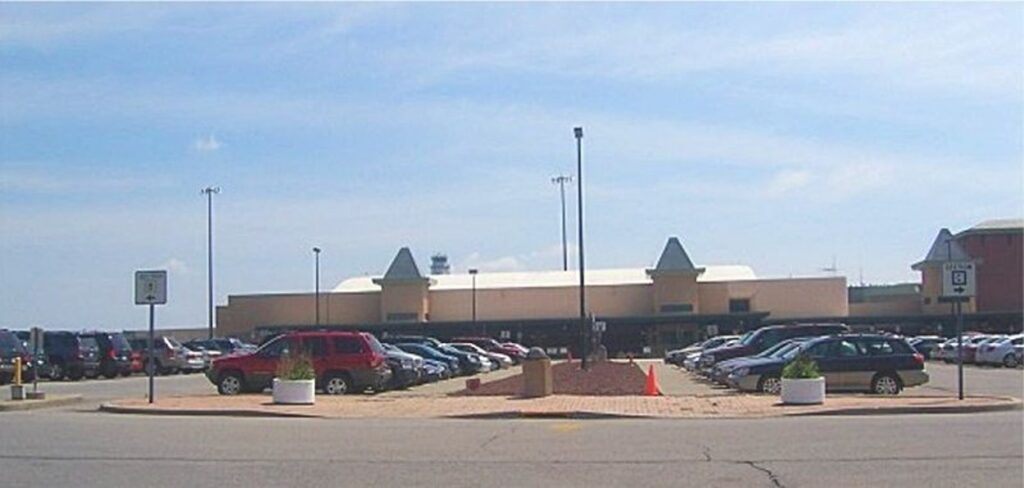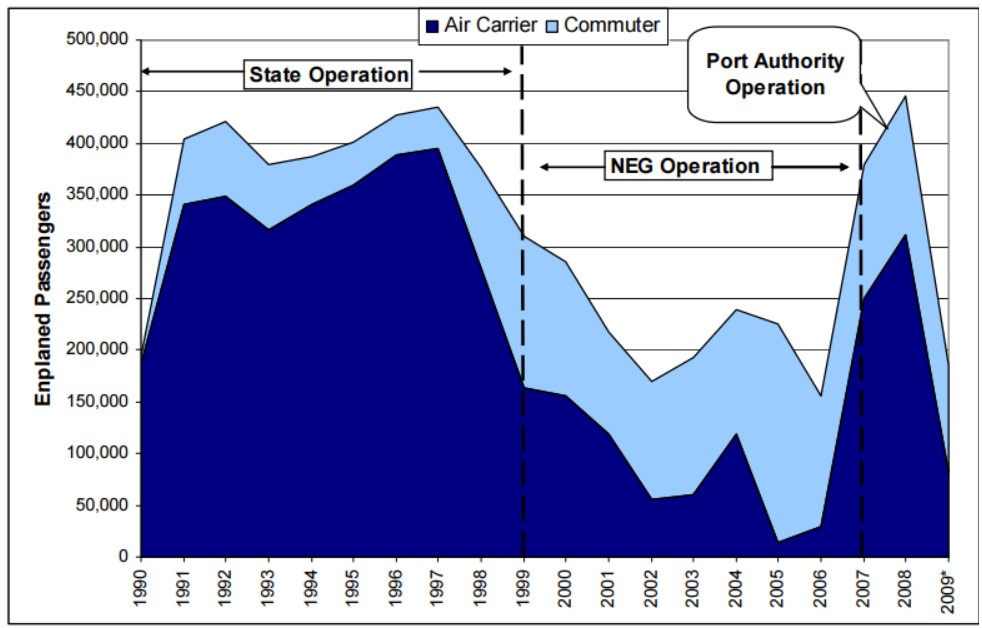Majority of the airports in the United States are owned and operated by city level local governments. Airport privatization in United States has not gained traction so far as in United Kingdom and Europe. The Airport Privatization Pilot Program launched by Congress in 1996 has not proved effective.
Nonetheless, it is important to look at the airports that were successfully privatized by United States and what were the results of that privatization. In this regard, we have dedicated this article to presenting the case study of privatization of Stewart International Airport – the first ever commercial airport to be privatized in United States.
It is a small airport located approximately 70 miles from the New York City. It is officially called New York Stewart International Airport. The airport has two runways and six boarding gates with a traffic of over 500,000 passengers per year.

It was the first airport to be pilot tested under the United States Airport Privatization Pilot Program (launched by Federal Aviation Administration in 1996). The airport was privatized in the year 2000 and became the first United States commercial airport to be privatized successfully under the program.
Out of the three main types of airport privatization, the airport was privatized through a lease contract agreement. The lease contract was won by National Express Group PLC, a British Transportation Company who paid USD 35 million upfront to the state of New York for a 99-year lease of the airport.
The State of New York intended to use the revenue generated from leasing the airport for development of other sectors. However, it is one of the conditions of the United States Airport Privatization Pilot Program that government cannot use funds generated from airport business on anywhere other than the airport itself (to make sure the money airport is making is used on development of the airport itself).
State of New York tried to get approval of airlines to use airport generated revenue elsewhere but didn’t get consent of 65% airlines (mandatory condition) therefore couldn’t do so. Nonetheless, New York state government was hopeful and content with the privatization of the airport.
Today is an historic day for New Yorkers because once again the Empire State is the national leader in new and innovative policies. With the eyes of the world on us, we have again returned government to its proper role of helping the private sector unleash its potential to create jobs and opportunities for the people. As we transfer Stewart to National Express Group, we are doing more than just turning over the keys. We are unlocking the door for the private sector to come in and provide the Hudson Valley region with better air travel services, greater economic development, and a strengthened tax base.
– Governor George Pataki of New York State, March 2000
National Express Group PLC took over airport operations on 1st April 2001. The company started off with enthusiasm and proposed a 5-year airport development plan worth nearly USD 50 million. It included improvements in deicing fluid collection system of the airport; a runway overlay; ramp expansions and replacements; construction of parallel taxiways; as well as design and development of a new cargo area.
Before privatization (when the airport was under state-ownership), the airport had made a profit of USD 1.89 million in the year 1999 but had turned a net loss of USD 1.128 million in the year 2000. Moreover, passenger traffic of the airport was declining at the time of privatization. Now it was time for the government to see if the new private owner is able to change these figures.
Unfortunately, the untoward events of 11th September 2001 caused disruption in air traffic of the United States air space. As referred above, the airport’s already declining passenger traffic was further impacted by the emergent circumstances. Reduced air traffic made a direct impact on airport’s financial performance. The new private owner of the airport faced a tough challenge as soon as it took over the airport.

However, National Express did not immediately crumble under the emergent circumstances. Despite the fact that the overall passenger traffic at the airport reduced by 38% from 1999 to 2003, the airport turned a net profit of USD 1.853 million in the year 2001 – the first year of privatization. The next year (2002), it made a profit of USD 1.418 million. It remained profitable in the third year as well by making USD 1.531 million in 2003. Maintaining profitability despite declining air traffic was attributed to efficient management of National Express.
The company engaged the aviation technology giant General Electric to build a USD 24 million corporate aviation center at the airport. General Electric moved its operation from Westchester County Airport to Stewart Airport.
National Express also managed a deal to develop private jet hangars at the airport for general aviation maintenance as well as another deal with First Columbia LLC – a major real estate company to promote the airport and an office park adjacent to the airport.
Another achievement attributed to privatization of the airport included attracting cargo traffic at the airport. After 2002, cargo traffic at the airport increased sharply. It dropped in the subsequent years but still remained well above the pre-privatization figures.

Although the performance of the National Express in the face of difficult circumstances seemed commendable, what the airport needed was more passengers. it had become a question of how long would the company fight the uphill battle in the airport business.
Although the passenger traffic got slightly better in the year 2004 and 2005, it again dropped sharply in 2006. National Express processed the case for changing the airport’s name from Stewart Airport to New York Hudson Valley International Airport as a marketing effort to attract more passengers but it could not be materialized due to local opposition.
Finally, in September 2006, National Express announced its plans to sell its remaining lease and exit Stewart International Airport. In a matter of 3-4 months, the Port Authority of New York and New Jersey purchased the airport back for USD 78.5 million. The Port Authority took over airport operations in November 2007.
The Port Authority recorded a loss of USD 0.8 Million in 2007 when it ran the airport for the remainder of the financial year. The loss was even greater in the next year at USD 5.5 million. It suggested that the private enterprise (National Express Group PLC) was not making net profit from the airport in its final period just before the sale.
Although the commonly attributed reason for National Express ending its ownership of Stewart Airport is considered as the declining passenger traffic that could not be restored, there is another reason worthy of discussion. It was the change in strategy of the company to exit the air transportation industry and shift to its core business of land transportation.
It is considered to be a contributing factor because National Express Group had approached United States Department of Transportation to relieve it of its lease obligations in 1999 i.e., even before taking over Stewart Airport’s operations.
Furthermore, the company had exited from its airport business in the United Kingdom when it sold three of its airports in United Kingdom in 2001. It included the sale of East Midlands Airport and Bournemouth Airport for £241 million to Manchester Airports Group (MAG).
The above facts indicate that National Express Group had entered into Stewart Airport’s ownership at a time when its corporate governance was deciding to remove itself from airport business. Therefore, declining passenger traffic may not be the sole reason for National Express Group’s decision to sell Stewart Airport back to the United States Port Authority.
Conclusively, Stewart International Airport remained under private ownership for six years (from the year 2000 to 2006) during which the private owner made many noteworthy improvements to the airport. However, in the end, the airport returned under ownership of the respective local government i.e., Port Authority of New York and New Jersey who is the owner and operator of the airport till date.
If you liked this article, share it with at least one person of common interest. It allows our work to be of service to people who can benefit from it the most.
You may also find this 3-hour online Airport Privatization Course interesting that explains all about airport privatization from its background and history and compares private airports with government-owned airports to develop good understanding of whether airport privatization is good or bad.
References:
- CRS Report “Airport Privatization: Issues and Options for Congress” by Congressional Research Service, 11th March 2021.
- “Report to Congress on the status of the Airport Privatization Pilot Program, United States Code, Title 49, Section 47134” by Federal Aviation Administration (FAA), United States Department of Transportation, August 2004.
- Publication “An Analysis of the Proposed Privatization of Chicago’s Midway Airport” by Casey Andrew Burton in Journal of Air Law and Commerce, Article 06, Volume 72, Issue 03, Year 2007.
- Appendix-H to Airport Cooperative Research Program Report ACRP 01-14: Considering and Evaluating Airport Privatization